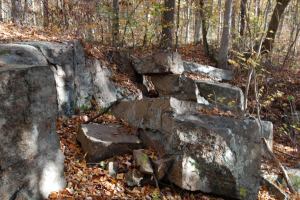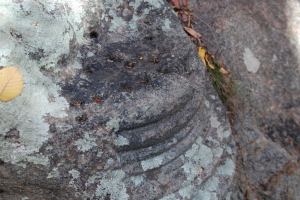by
David Leff
Towering trees with spreading crowns combined with a hushed sylvan quiet sometimes makes stepping into the woods feel like entering a cathedral. Perhaps just such an experience contributes to a belief by some people that within Connecticut’s Cockaponset State Forest in Guilford is a 5th century Byzantine Church, the oldest Christian house of worship in North America. But don’t expect ruined walls, belfry remains or pews. It’s more of an outdoor chapel, a space in the woods with interesting carving in the bedrock that most people wouldn’t notice unless they were looking for it.

Among the sculptures are a stalagmite-like floral
 creation, a flame shaped basin carved into a ledge and surrounded by
drill holes, a rock formed into a seat, a four petal flower, and a
freestanding rectangular basin. A large rock outcrop is carved with a
series of stepped grooves above which is a small flattened area surrounded by drill holes.
creation, a flame shaped basin carved into a ledge and surrounded by
drill holes, a rock formed into a seat, a four petal flower, and a
freestanding rectangular basin. A large rock outcrop is carved with a
series of stepped grooves above which is a small flattened area surrounded by drill holes.Subscribers to the church theory see inscriptions
 in
the rocks which suggest that the carving was the work of North African
Monks 1,500 years ago. They see the basins as baptismal fonts, the seat
as a throne, and the flattened and grooved chunk of ledge as an altar.
Vertical drill holes are candle holders and the horizontal ones reveal
patterns with images and letters. A more prosaic alternative holds that
this little plateau was the lunch site of quarrymen
carving out blocks for railroad abutments and bridges little more than a
century ago. In spare moments they doodled, practicing their mason
skills to pass the time.
in
the rocks which suggest that the carving was the work of North African
Monks 1,500 years ago. They see the basins as baptismal fonts, the seat
as a throne, and the flattened and grooved chunk of ledge as an altar.
Vertical drill holes are candle holders and the horizontal ones reveal
patterns with images and letters. A more prosaic alternative holds that
this little plateau was the lunch site of quarrymen
carving out blocks for railroad abutments and bridges little more than a
century ago. In spare moments they doodled, practicing their mason
skills to pass the time.Regardless of whether the carvings are the work of ancient monks or the graffiti of nineteenth century stonemasons, these primitive sculptures are both beautiful and intriguing. It’s tempting to believe the
 more complex and antique (albeit bizarre)explanation
because it adds a mystical allure to the site, though I can better
imagine the quarry crew eating and swapping stories as they tried their
talent. There is a magic in the juxtaposition of such different
interpretations. In any event, the presence of these sculptures among
the trees adds depth and texture to the landscape and elevates a simple
walk in the woods with a mix of awe and wonder.
more complex and antique (albeit bizarre)explanation
because it adds a mystical allure to the site, though I can better
imagine the quarry crew eating and swapping stories as they tried their
talent. There is a magic in the juxtaposition of such different
interpretations. In any event, the presence of these sculptures among
the trees adds depth and texture to the landscape and elevates a simple
walk in the woods with a mix of awe and wonder.08.10.2010
http://davidkleff.typepad.com/home/2010/11/byzantine-church-or-stonemason-doodling.html
———————–
Σχετικά με τον συντάκτη της ανάρτησης:
Η ιστοσελίδα μας δημιουργήθηκε το 2008.Δείτε τους συντελεστές και την ταυτότητα της προσπάθειας. Επικοινωνήστε μαζί μας εδώ .








κανένα σχόλιο